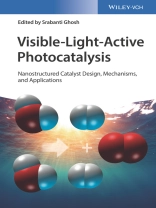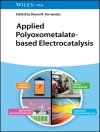A comprehensive and timely overview of this important and hot topic, with special emphasis placed on environmental applications and the potential for solar light harvesting.
Following introductory chapters on environmental photocatalysis, water splitting, and applications in synthetic chemistry, further chapters focus on the synthesis and design of photocatalysts, solar energy conversion, and such environmental aspects as the removal of water pollutants, photocatalytic conversion of CO2. Besides metal oxide-based photocatalysts, the authors cover other relevant material classes including carbon-based nanomaterials and novel hybrid materials. Chapters on mechanistic aspects, computational modeling of photocatalysis and Challenges and perspectives of solar reactor design for industrial applications complete this unique survey of the subject.
With its in-depth discussions ranging from a comprehensive understanding to the engineering of materials and applied devices, this is an invaluable resource for a range of disciplines.
表中的内容
PART I: VISIBLE LIGHT ACTIVE PHOTOCATALYSIS – RESEARCH AND TECHNOLOGICAL ADVANCEMENTS
Research frontiers in solar light harvesting
Recent advances on photocatalysis for water detoxification and CO2 reduction
Fundamentals of photocatalytic water splitting (Hydrogen and oxygen evolution)
Photoredox catalytic activation of carbon-halogen bonds
PART II: DESIGN AND DEVELOPMENTS OF VISIBLE LIGHT ACTIVE PHOTOCATALYSTS
Black Ti O2: The New Generation Photocatalyst
Effect of Modification of Ti O2 with Metal Nanoparticles on its Photocatalytic Properties Studied by Time Resolved Microwave Conductivity
Glassy photocatalysts: New trend in solar photocatalysis
Visible-Light-Active Photocatalysis: Nanostructured Catalyst Design, Mechanisms, and Application
Conducting Polymers Nanostructures as Novel Materials for Efficient Solar Light Harvesting
PART III: VISIBLE LIGHT ACTIVE PHOTOCATALYSIS FOR SOLAR ENERGY CONVERSION AND ENVIRONMENTAL PROTECTION
Sensitization of Ti O2 by dyes: a way to extend the range of photocatalytic activity of Ti O2 to the visible region
Recent progress in novel photocatalysts for detoxification
Metal-free Organic Semiconductors for Visible Light Photocatalytic Water Splitting
Solar Photochemical Splitting of Water
Visible Light Photoredox Catalysis by Organic Dyes for Organic Synthesis
Visible Light Heterogeneous Catalysts for Photocatalytic CO2 Reduction
PART IV: MECHANISTIC STUDIES OF VISIBLE LIGHT ACTIVE PHOTOCATALYSIS
Band-gap engineering of photocatalysts: Optical, electronic, and catalytic Modifications
Roles of the active species generated during photocatalysis
Visible-Light-Active Photocatalysis: Nanostructured Catalyst Design, Mechanisms, and Applications
PART V: CHALLENGES AND PERSPECTIVES OF VISIBLE LIGHT ACTIVE PHOTOCATALYSIS FOR LARGE SCALE APPLICATIONS
Quantum Effects in Modeling Photocatalytic Processes
An overview of solar photocatalytic reactor designs and their broader impact on the environment
Conclusions and Future work
关于作者
Dr. Srabanti Ghosh is currently a Senior Research Associate (Scientists’ Pool Scheme) in the Fuel Cell and Battery Division, at the CSIR-Central Glass and Ceramic Research Institute in Kolkota, India. She received her Ph D in 2010 from UGC-DAE Consortium for Scientific Research, Kolkata Centre and Jadavpur University, Kolkata, followed by a position as research associate at the Centre for Advanced Material, Indian Association for the Cultivation of Science in Kolkota. After a research stay as a postdoctoral fellow (RBUCE UP, Marie Curie Cofund) at the Laboratoire de Chimie Physique, University of Paris-Sud, France, she was appointed as Visiting Assistant Professor at the S. N. Bose National Centre for Basic Sciences in Kolkata, India. Her research interests encompass synthesis and applications of semiconductor, graphene and polymer-based nanomaterials, sensing, solar light harvesting, liquid fuel cells and catalysis











